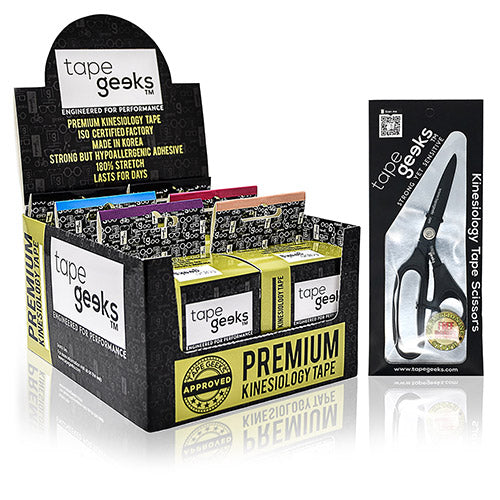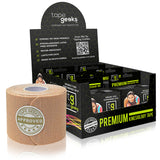
A rotator cuff is a group of muscles and tendons that hold the shoulder joint in place and help you lift your arm. A tear in the rotator cuff can cause pain and weakness in the shoulder.
Do you want to know more about rotator cuff tears?
In this article, we’ll be talking about the different causes of a rotator cuff tear, its symptoms, how to diagnose it, and its available treatments. We’ll also be discussing a kinesiology tape protocol that will help alleviate some of the discomforts from this injury while giving support to the area.

Shop our kinesiology tape now
Shop Now
What are the different types of rotator cuff tears?
- Partial tear. A partial tear happens when a part of the rotator cuff tendon is still attached to the arm bone.
- Complete tear. A complete tear happens when the tendon completely detaches from the arm bone.
What are the causes and risk factors of a rotator cuff tear?

The most common cause of a rotator cuff tear is overuse. Athletes and workers who do a lot of overhead lifting are at risk of developing a rotator cuff tear.
- Bone overgrowth. Bone spurs or bony growths that form on top of the shoulder bone can rub against your tendons when you’re raising your arms.
- Overuse. Doing repetitive shoulder motions can stress your muscles and tendons which may lead to a tear. Some jobs that involve repetitive shoulder motions like carpentry, painting, and repairing vehicles puts you more at risk for rotator cuff tear.
- Age. Being 40 years or older makes you more prone to rotator cuff tears.
- Genetics. Having a family history of rotator cuff tears increases your risk of developing one.
- Playing certain sports. Playing sports that put a strain on your rotator cuffs like tennis, baseball, rowing, and the like makes you more prone to tears.
Other factors that increase your risk for rotator cuff tears include smoking and having poor posture.
What are the symptoms of a tear in the rotator cuff?
Here are some of the most common symptoms that you’ll experience if you have a rotator cuff tear:
- Pain when lifting your arm
- Popping or clicking sounds during arm movements
- Pain when resting at night
- Weakness in your shoulders
How do you diagnose a rotator cuff tear?

Your doctor will perform a physical examination and ask about your symptoms. He or she may also order imaging tests, such as an MRI, to help diagnose the tear.
- Magnetic Resonance Imaging (MRI)
- X-ray
- Ultrasound
What are the available treatments for a rotator cuff tear?

If you are experiencing shoulder pain, see your doctor determine if you have a rotator cuff tear. The treatment options vary depending on the cause and severity of the tear.
- Rest. Your healthcare provider may recommend that you rest your shoulder and refrain from doing activities that involve overhead movements. You may need to rest your shoulder for a few days or weeks. This will allow the rotator cuff muscles and tendons to heal.
- Ice. Apply ice packs to your shoulder for 20 minutes at a time, four times a day. This will help reduce inflammation and pain.
- Anti-inflammatory drugs. Taking anti-inflammatory medication may help in easing pain and inflammation.
- Steroid injections. Your health care provider may prescribe steroid injections to relieve pain temporarily.
- Kinesiology tape. While not a treatment per se, kinesiology tape helps in giving support for rotator cuff tears, relieves some of the discomforts, and won’t limit your range of motion.

Shop our bundles now
Shop Now
- Surgery. If the tear is severe, surgical repair involves repairing the torn rotator cuff. Surgery may be needed if the tear is large or if the pain does not improve with non-surgical treatment
- Physical therapy. Undergoing physical therapy can help improve the strength and range of motion in your shoulder.
What can kinesiology tape do for a rotator cuff tear?
While not enough to heal a massive rotator cuff tear, kinesiology tape can be used to help reduce inflammation and give support to the area without having to restrict your range of motion.
Before your shoulder application, here are some tips on how to prepare beforehand. And, since you’ll be applying different kinesiology tape tensions, learn more about it here.
Watch the video to learn a kinesiology taping protocol that may help you relieve discomfort from a rotator cuff tear.
Tape Geeks: The best skin-friendly kinesiology tape for your rotator cuff
Get support for your rotator cuff without damaging your skin with Tape Geeks! Made from high-quality adhesives, you can avoid skin rashes and allergies.
Enjoy a great stick without making your skin sick with Tape Geeks kinesiology tape! TG tapes are hypoallergenic, zinc-free, and latex-free. What’s more, they’re manufactured in an ISO-certified and dermatologist-approved factory in South Korea which is known for their consistent and reliable adhesives.
Get the best deals for Tape Geeks' products by visiting our Amazon store today!
How long does it take for a torn rotator cuff to heal without surgery?
This depends on the cause and severity of the rotator cuff tear. With rest, ice, and physical therapy, mild rotator cuff tears can heal within four weeks. For more severe cases, it may take about four to six months or longer.
If the tear is more severe, or if non-surgical treatments do not relieve symptoms, surgery may be needed.
What happens if a rotator cuff injury goes untreated?
When left untreated, rotator cuff tears can get worse. Eventually, you’ll experience more pain and lose your range of motion. You’ll also lose shoulder strength and it’ll be challenging to perform daily activities.
Can rotator cuff tear heal on its own?
Most rotator cuff tears will not heal on their own and will require surgery. However, there are some things you can do to help reduce pain and improve mobility in the meantime such as icing the shoulder regularly, using a sling to keep the arm immobilized, and taking over-the-counter pain medication.

Shop our collection now
Shop Now
How do you prevent a rotator cuff tear in the future?
There is no sure way to prevent a rotator cuff tear, but taking steps to reduce your risk of injury can help. Here are some things that you can do to help reduce your chances of having these types of tears:
- Avoid repetitive overhead activity. Be aware of the motions or activities (like heavy lifting)that put you at risk for a rotator cuff tear and try to avoid them.
- Regularly exercise your shoulders. Strengthening the rotator cuff muscles can help protect them from injury.
- Warming up before exercise. A rotator cuff tear is often caused by repetitive overhead motions. Warming up before you exercise can help loosen the muscles and reduce your risk of injury.
- Seek a healthcare provider when experiencing shoulder pain. If you do experience a rotator cuff tear, seek treatment right away. early treatment is often the best way to prevent long-term damage and improve the outcome of rotator cuff surgery.
Conclusion
Thank you for reading our article on rotator cuff tears. We hope that you found it informative and that it has helped you to better understand this injury.
If you want to learn more about other aches and pains, be sure to check out the Tape Geeks blog for more helpful articles on a variety of health and wellness topics.
We encourage you to check out our blog for more in-depth articles on topics such as golfer’s elbow.

Shop our accessories and more
Shop NowSubscribe to the TapeGeeks Newsletter for new videos, discounts and more!Join The Geeks Club









